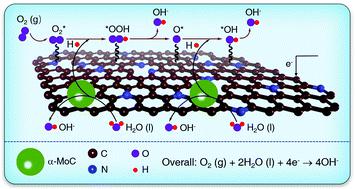当前位置:
X-MOL 学术
›
Energy Environ. Sci.
›
论文详情
Our official English website, www.x-mol.net, welcomes your
feedback! (Note: you will need to create a separate account there.)
Promoted oxygen reduction kinetics on nitrogen-doped hierarchically porous carbon by engineering proton-feeding centers
Energy & Environmental Science ( IF 32.4 ) Pub Date : 2020-07-13 , DOI: 10.1039/d0ee01613f Guangbo Chen 1, 2, 3, 4 , Tao Wang 5, 6, 7, 8, 9 , Pan Liu 10, 11, 12, 13 , Zhongquan Liao 4, 14, 15, 16 , Haixia Zhong 1, 2, 3, 4 , Gang Wang 1, 2, 3, 4 , Panpan Zhang 1, 2, 3, 4 , Minghao Yu 1, 2, 3, 4 , Ehrenfried Zschech 4, 14, 15, 16 , Mingwei Chen 9, 17, 18, 19 , Jian Zhang 13, 20, 21, 22, 23 , Xinliang Feng 1, 2, 3, 4
Energy & Environmental Science ( IF 32.4 ) Pub Date : 2020-07-13 , DOI: 10.1039/d0ee01613f Guangbo Chen 1, 2, 3, 4 , Tao Wang 5, 6, 7, 8, 9 , Pan Liu 10, 11, 12, 13 , Zhongquan Liao 4, 14, 15, 16 , Haixia Zhong 1, 2, 3, 4 , Gang Wang 1, 2, 3, 4 , Panpan Zhang 1, 2, 3, 4 , Minghao Yu 1, 2, 3, 4 , Ehrenfried Zschech 4, 14, 15, 16 , Mingwei Chen 9, 17, 18, 19 , Jian Zhang 13, 20, 21, 22, 23 , Xinliang Feng 1, 2, 3, 4
Affiliation

|
Electrocatalytic oxygen reduction reaction (ORR) is the vital process for next-generation electrochemical energy storage and conversion technologies, e.g., metal–air batteries and fuel cells. During the ORR, the O2* and O* intermediates principally combine with protons to form OOH* and OH* species, respectively, which are the proton-coupled electron transfer processes. Unfortunately, under alkaline conditions, the protons are essentially generated from the sluggish water dissociation process, which unavoidably limits the ORR kinetics. Herein, we design and synthesize a nitrogen-doped hierarchically porous carbon with homogeneously distributed ultrafine α-MoC nanoparticles (α-MoC/NHPC) as a model electrocatalyst. Theoretical investigations unveil that α-MoC on NHPC could efficiently reduce the energy barrier of the water dissociation process to generate protons, eventually promoting the proton-coupled ORR kinetics. In a 0.1 M KOH aqueous solution, α-MoC/NHPC exhibits excellent ORR performance with a high half-wave potential of 0.88 V (VS. reversible hydrogen electrode), which outperforms those for NHPC and commercial Pt/C. Moreover, as the air electrode in a zinc-air battery, α-MoC/NHPC presents a large peak power density of 200.3 mW cm−2 and long-term stability. Thereby, our approach to engineering proton-feeding centers paves a new avenue towards the understanding of ORR kinetics and the development of high-performance ORR electrocatalysts.
中文翻译:

通过工程质子进料中心促进掺氮分级多孔碳的氧还原动力学
电催化氧还原反应(ORR)是下一代电化学能量存储和转换技术(例如金属-空气电池和燃料电池)的重要过程。在ORR期间,O 2*和O *中间体主要与质子结合形成OOH *和OH *物质,这是质子耦合的电子转移过程。不幸的是,在碱性条件下,质子基本上是由缓慢的水离解过程产生的,这不可避免地限制了ORR动力学。本文中,我们设计并合成了均匀分布的超细α-MoC纳米颗粒(α-MoC/ NHPC)作为模型电催化剂的氮掺杂的分级多孔碳。理论研究表明,NHPC上的α-MoC可以有效降低水离解过程产生质子的能垒,最终促进质子偶联的ORR动力学。在0.1 M KOH水溶液中,α-MoC/ NHPC具有极好的ORR性能,且半波电势高达0.88 V(VS。可逆氢电极),其性能优于NHPC和商用Pt / C。此外,作为锌-空气电池中的空气电极,α-MoC/ NHPC具有200.3 mW cm -2的大峰值功率密度和长期稳定性。因此,我们设计质子进料中心的方法为了解ORR动力学和开发高性能ORR电催化剂开辟了一条新途径。
更新日期:2020-09-16
中文翻译:

通过工程质子进料中心促进掺氮分级多孔碳的氧还原动力学
电催化氧还原反应(ORR)是下一代电化学能量存储和转换技术(例如金属-空气电池和燃料电池)的重要过程。在ORR期间,O 2*和O *中间体主要与质子结合形成OOH *和OH *物质,这是质子耦合的电子转移过程。不幸的是,在碱性条件下,质子基本上是由缓慢的水离解过程产生的,这不可避免地限制了ORR动力学。本文中,我们设计并合成了均匀分布的超细α-MoC纳米颗粒(α-MoC/ NHPC)作为模型电催化剂的氮掺杂的分级多孔碳。理论研究表明,NHPC上的α-MoC可以有效降低水离解过程产生质子的能垒,最终促进质子偶联的ORR动力学。在0.1 M KOH水溶液中,α-MoC/ NHPC具有极好的ORR性能,且半波电势高达0.88 V(VS。可逆氢电极),其性能优于NHPC和商用Pt / C。此外,作为锌-空气电池中的空气电极,α-MoC/ NHPC具有200.3 mW cm -2的大峰值功率密度和长期稳定性。因此,我们设计质子进料中心的方法为了解ORR动力学和开发高性能ORR电催化剂开辟了一条新途径。











































 京公网安备 11010802027423号
京公网安备 11010802027423号